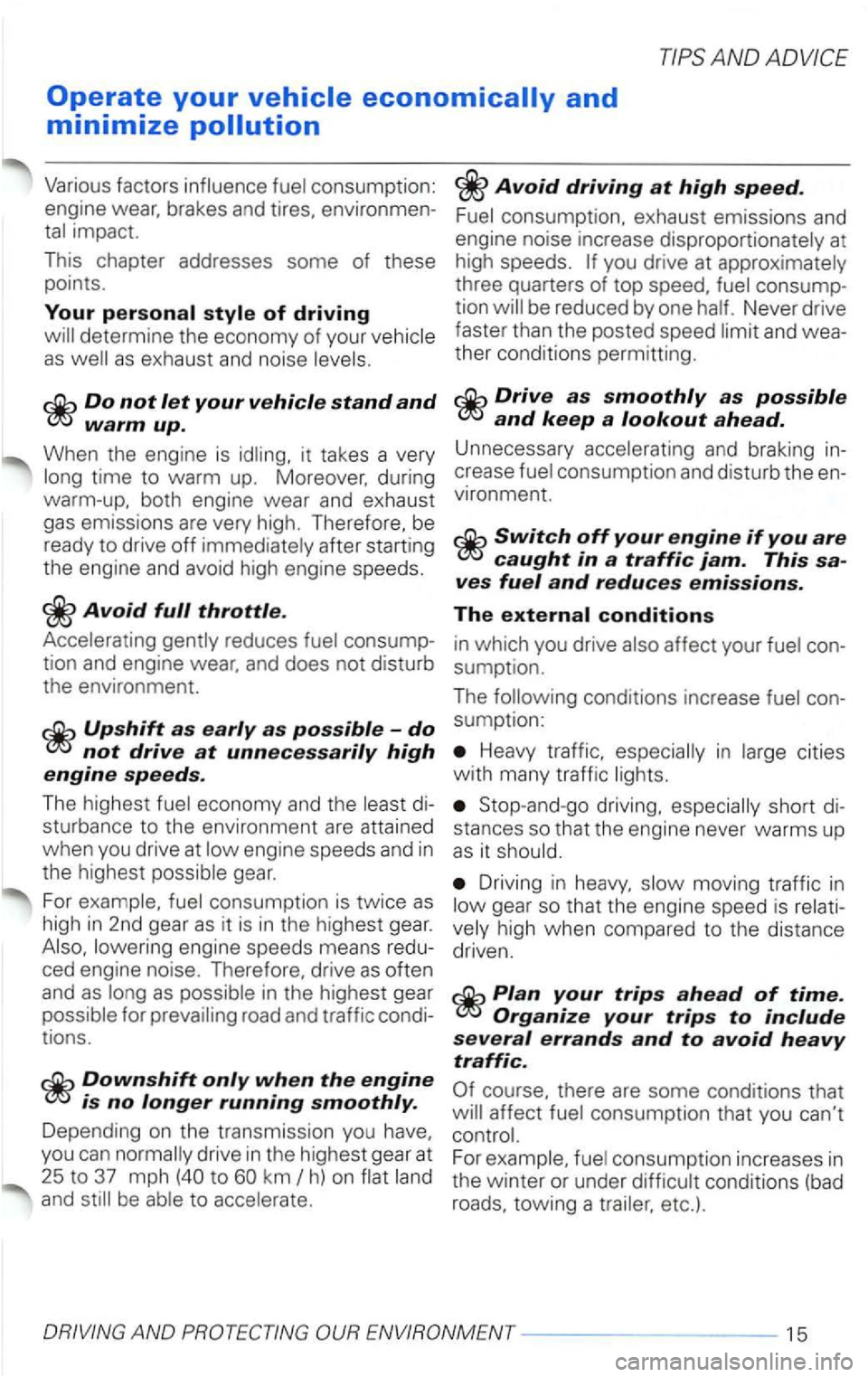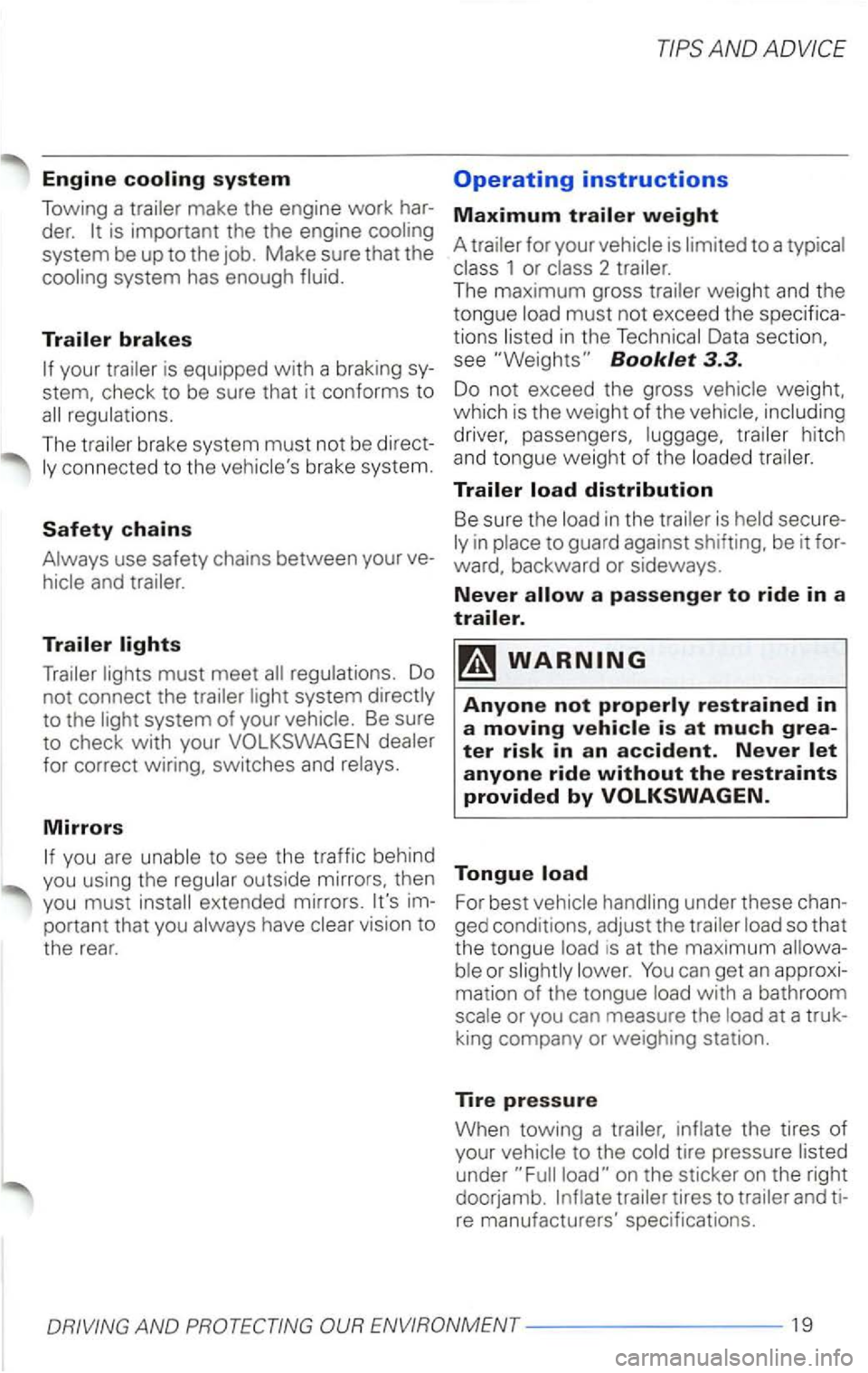trailer VOLKSWAGEN PASSAT 2004 Owners Manual
[x] Cancel search | Manufacturer: VOLKSWAGEN, Model Year: 2004, Model line: PASSAT, Model: VOLKSWAGEN PASSAT 2004Pages: 483, PDF Size: 78.54 MB
Page 376 of 483

Various factors influence fuel consumption:
engine wear. brakes
and tires, environmen
tal impact.
T his chapter addresses some of these
points.
Your
warm up.
When the engine is idling, it takes a very
long time to warm
up. Moreover. during
warm-up, both engine wear and exhaust
gas emissions are very high. Therefore, be
ready to drive
off immediately after starting
the engine and avoid high engine speeds.
Avoid
Upshift as early as possible -do not drive at unnecessarily high engine speeds.
The highest fuel economy and the least di
sturbance to the environment are attained
when you drive at l
ow engine speeds and in
the highest possible gear.
For example , fuel consumption is twice
as high in 2nd gear as it is in the highest gear.
Downshift only when the engine is no longer running smoothly.
Depending on the transmission you have.
you can normally drive in the highest gear at
25 to 37 mph
(40 to km
Avoid driving at high speed.
Fuel consumption, exhaust emissions and
engine noise increase disproportionately at
high speeds.
you drive at approximately
three quarters of top speed, fuel consump
tion
be reduced by one half. Never drive
faster than the posted speed limit and wea
ther condit ions permitting.
Drive as smoothly as possible and keep a lookout ahead.
Unnecessary accelerating and braking in
crease fuel consumption and disturb the en
vironment.
Switch off your engine if you are caught in a traffic jam. This sa
ves fuel and reduces emissions.
The
Heavy traffic, especially in large cities
w ith many traffic lights.
Stop-and-go driving, especially short di
stances so that the engine never warms up as it should.
Driving in heavy, slow moving traffic in low gear so that the engine speed is relati
vely high when compared to the distance
driven.
Plan your trips ahead of time. Organize your trips to include several errands and to avoid heavy traffic.
course. there are some conditions that affect fuel consumption that you can't
control.
For example, fuel consumption increases in
the wint er or under difficult conditions
(bad roads. towing a trailer. etc.).
DRIVING AND
Page 379 of 483

AND
Warranty coverages
is cove red by the ing warranties .
Limited New
Limited Warranty
Limited Warranty Against
Emissions Warranty
Emissions
Emissions
Trailer towing*
to tow a remembe r that your
car
economy and performance.
the oper
ating and driving instructions given and use
common sense.
Emissions ranty
Use a weight-carrying hitch conforming to
See Booklet 1.2 . the gross
to appropriate on the
remove
the mount. This prevents
the hitch from causing damage
When you are no towing a
remove the entire hitch. When doing
to prevent water and
exhaust fumes from entering the
18 ---------DRIVING AND
Page 380 of 483

Engine
is im portant the the engine
system be up to the job. Make sure that the
your
brake system must not be direct
use safety chains between your ve
must meet regulations . Do
not connect the
system directly
to the sys tem of your Be sure
to check with your
Mirrors
you are
extended mirrors.
have vision to
the
rear.
AND ADVICE
Operating instructions
Maximum
to a
1 or 2 trailer.
The maximum gross weight and the
tong
ue
Booklet 3.3.
Do not exceed the g ross weight.
w hich is the weight of the veh ic le. inclu ding
dr
iver. passen g ers . luggage. hitch
and tongue weight of the trailer.
in the is secure
to guard against be it for
ward. backward or sideways .
Never
Fo r best hand ling under these chan
ged condit ions. adjust the
is at the maximum or You can get an approxi
mation of the tong ue
the tires of y our to the
unde r on the sticker on the right
doorjamb . tires to and tire manufacturers' specifications.
DRIVING AND ENVIRONMENT ---------19
Page 382 of 483

Trailer towing tips
when to
wing a
weight and weig ht distribution. per
formance and economy depend
on
how your and
operate your rig.
Before you
tow your
you the
unit.
Backing up is
and requires practice.
Steering
wi
thout a
you need
a
than turn ing radius.
When passing, remember that you cannot
be
cause
of the added Make sure you have enough room to pass. After passing. of room for your
changes.
AND
After parking , the and
on a it cannot be avoided. do
so
foot brake .
Have someone chocks under both
With chocks in bra
kes
Turn to curb.
parking brake.
and
transmission in first or reverse gear.
you move the
the
to
move the position.
When restarting after parking on a
the engine.
the parking brake and
and have someone retrieve the
Notes
your may require more frequent maintenance
due to the extra
page 31.
DRIVING AND ENVIRONMENT---------21